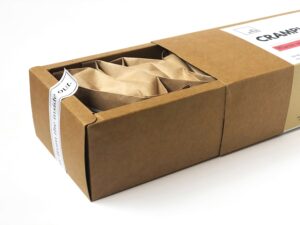In recent years, the conversation surrounding sustainable packaging has gained significant momentum. As you navigate through grocery aisles or browse online shopping platforms, you may have noticed a growing emphasis on eco-friendly materials and practices. This shift is not merely a trend; it reflects a broader awareness of environmental issues and a collective desire to reduce our ecological footprint.
Sustainable packaging encompasses a range of strategies aimed at minimizing waste, conserving resources, and promoting the use of renewable materials. It is a response to the alarming statistics regarding plastic pollution and the urgent need for businesses and consumers alike to adopt more responsible practices. You might wonder why sustainable packaging matters.
The reality is that traditional packaging methods often contribute to environmental degradation, from excessive plastic waste in landfills to the depletion of natural resources. By embracing sustainable alternatives, you can play a part in mitigating these impacts. Whether you are a consumer making conscious choices or a business owner seeking to align with eco-friendly practices, understanding the principles of sustainable packaging is essential.
This article will explore innovative materials, minimalist design approaches, technological advancements, collaborative efforts, consumer education, and the broader implications for businesses in the realm of sustainable packaging.
Key Takeaways
- Sustainable packaging aims to reduce environmental impact and promote the use of renewable resources.
- Innovative materials such as bioplastics, mushroom packaging, and seaweed-based packaging offer eco-friendly alternatives to traditional packaging materials.
- Minimalist design focuses on reducing unnecessary packaging and using materials that are easily recyclable or biodegradable.
- Technology plays a crucial role in sustainable packaging through the use of smart packaging, blockchain for supply chain transparency, and 3D printing for customized packaging solutions.
- Collaborative efforts between businesses, governments, and consumers are essential for creating a more sustainable packaging ecosystem.
- Consumer education and behavior change are key in promoting the adoption of sustainable packaging practices and reducing waste.
- Sustainable packaging can have a positive impact on businesses by reducing costs, enhancing brand reputation, and meeting consumer demand for eco-friendly products.
- Future trends in sustainable packaging include the use of advanced recycling technologies, edible packaging, and the development of circular packaging systems.
Innovative Materials for Eco-Friendly Packaging
As you delve deeper into the world of sustainable packaging, you’ll discover a plethora of innovative materials that are transforming the industry. One of the most exciting developments is the rise of biodegradable plastics made from natural sources such as cornstarch or sugarcane. These materials break down more easily in the environment compared to traditional petroleum-based plastics, offering a promising alternative for packaging solutions.
You may find products packaged in these materials that not only serve their purpose effectively but also contribute to a healthier planet. Another noteworthy innovation is the use of recycled materials in packaging design. Many companies are now utilizing post-consumer recycled content to create new packaging products.
This not only reduces the demand for virgin materials but also helps divert waste from landfills. As you consider your purchasing decisions, look for brands that prioritize recycled content in their packaging. Additionally, advancements in paper and cardboard technologies have led to stronger, more durable options that can replace plastic in various applications.
These materials are often sourced from sustainably managed forests, ensuring that your choices support responsible forestry practices.
Reducing Packaging Waste with Minimalist Design

In your quest for sustainable packaging solutions, you may encounter the concept of minimalist design. This approach emphasizes simplicity and functionality, aiming to reduce excess material while maintaining product integrity. By adopting minimalist design principles, brands can significantly decrease their packaging waste.
The Role of Technology in Sustainable Packaging
| Metrics | Data |
|---|---|
| Reduction in Material Usage | Technology has enabled a 30% reduction in material usage for sustainable packaging. |
| Recyclability Rate | With the use of advanced technology, the recyclability rate of packaging materials has increased to 80%. |
| Energy Efficiency | Technology has improved energy efficiency in packaging production by 25%. |
| Carbon Emissions Reduction | Advanced technology has led to a 20% reduction in carbon emissions associated with packaging manufacturing. |
| Biodegradability | New technological advancements have increased the biodegradability of packaging materials by 40%. |
Technology plays a pivotal role in advancing sustainable packaging solutions. As you explore this field, you’ll find that innovations such as smart packaging and digital printing are revolutionizing how products are packaged and marketed. Smart packaging incorporates sensors and indicators that can provide real-time information about a product’s freshness or condition.
This not only enhances the consumer experience but also reduces food waste by ensuring that products are consumed at their peak quality. Digital printing technology has also transformed packaging design by allowing for more customization and reduced waste during production. You may notice that brands can now produce smaller batches of packaging with unique designs tailored to specific markets or events.
This flexibility minimizes excess inventory and reduces the environmental impact associated with overproduction. As technology continues to evolve, it opens up new possibilities for creating sustainable packaging solutions that align with consumer preferences and environmental goals.
Collaborative Efforts in Sustainable Packaging
The journey toward sustainable packaging is not one that can be undertaken alone; it requires collaboration across various sectors. You may be surprised to learn how companies, governments, and non-profit organizations are coming together to address the challenges associated with packaging waste. Initiatives such as industry coalitions and partnerships aim to share best practices, develop standards, and promote innovation in sustainable packaging.
As a consumer, your support for brands that engage in collaborative efforts can amplify their impact. When companies work together to create shared goals and solutions, they can drive systemic change within the industry. For instance, some brands have committed to using 100% recyclable or compostable packaging by a certain date, demonstrating their dedication to sustainability.
By choosing to support these brands, you contribute to a collective movement toward more responsible packaging practices.
Consumer Education and Behavior Change

Your role as a consumer is crucial in the transition to sustainable packaging. Education plays a significant part in shaping your understanding of what constitutes eco-friendly packaging and why it matters. As you become more informed about the environmental impacts of traditional packaging methods, you may feel empowered to make conscious choices that align with your values.
Behavior change is another essential aspect of this journey. You might find yourself gravitating toward brands that prioritize sustainability or seeking out products with minimal or recyclable packaging. By sharing your knowledge with friends and family, you can help raise awareness about the importance of sustainable packaging within your community.
The more consumers demand eco-friendly options, the more businesses will be motivated to adopt sustainable practices.
The Impact of Sustainable Packaging on Businesses
For businesses, embracing sustainable packaging is not just an ethical choice; it can also yield significant benefits. As you observe market trends, you’ll notice that consumers increasingly prefer brands that demonstrate environmental responsibility. By adopting sustainable packaging practices, companies can enhance their brand image and attract a loyal customer base that values sustainability.
Moreover, sustainable packaging can lead to cost savings in the long run. While there may be initial investments involved in transitioning to eco-friendly materials or redesigning packaging processes, many businesses find that they can reduce costs associated with waste disposal and raw material procurement over time. As you consider your purchasing decisions, remember that supporting businesses committed to sustainability can drive positive change within the industry.
Future Trends in Sustainable Packaging
Looking ahead, the future of sustainable packaging appears promising as innovation continues to flourish. You may witness an increasing focus on circular economy principles, where materials are reused and recycled rather than discarded after a single use. Brands are likely to explore new ways to design products and packaging that facilitate this cycle, creating a more sustainable system overall.
Additionally, advancements in bioplastics and alternative materials will likely expand the options available for eco-friendly packaging solutions. As research progresses, you may see new materials emerge that offer even greater environmental benefits while maintaining functionality and aesthetic appeal. The ongoing dialogue around sustainability will continue to shape consumer preferences and drive businesses toward more responsible practices.
In conclusion, your engagement with sustainable packaging can have far-reaching effects on both the environment and the economy. By understanding innovative materials, minimalist design principles, technological advancements, collaborative efforts, consumer education, and the impact on businesses, you can make informed choices that contribute to a more sustainable future. As trends evolve and new solutions emerge, your role as a conscious consumer will remain vital in shaping the landscape of sustainable packaging for years to come.
If you are interested in modern packaging ideas, you may want to check out the blog section of Blur&Co’s website. They offer insightful articles on packaging trends and innovative design ideas that can help your products stand out on the shelves. One article that caught my eye is “The Future of Sustainable Packaging,” which discusses the importance of eco-friendly packaging solutions in today’s market. You can read more about it here.
FAQs
What are modern packaging ideas?
Modern packaging ideas refer to innovative and creative ways of designing and presenting products in a way that is visually appealing, functional, and environmentally friendly.
What are some examples of modern packaging ideas?
Examples of modern packaging ideas include minimalist designs, sustainable materials such as biodegradable or recyclable packaging, interactive packaging with QR codes or augmented reality, and multi-functional packaging that can be repurposed.
Why are modern packaging ideas important?
Modern packaging ideas are important because they can help products stand out in a crowded market, reduce environmental impact, and enhance the overall customer experience.
How can modern packaging ideas benefit businesses?
Modern packaging ideas can benefit businesses by increasing brand recognition, reducing packaging costs, attracting environmentally conscious consumers, and differentiating products from competitors.
What are some trends in modern packaging ideas?
Some trends in modern packaging ideas include sustainable packaging solutions, minimalist and clean designs, personalized packaging, and smart packaging that incorporates technology.
How can businesses implement modern packaging ideas?
Businesses can implement modern packaging ideas by working with packaging designers, using sustainable materials, incorporating interactive elements, and staying updated on industry trends and consumer preferences.




